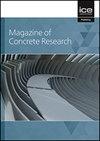Influential factors on concrete carbonation-a review
IF 1.8
4区 工程技术
Q3 CONSTRUCTION & BUILDING TECHNOLOGY
引用次数: 0
Abstract
After water, concrete is the most widely used substance on the planet. Cementitious materials carbonation is an inevitable process through which concrete compositions react with carbon dioxide. Carbonation leads to rebar corrosion in reinforced concrete (RC) structures which reduces the structures' longevity. This process increases cement production due to the repair and replacement which brings about more carbon dioxide emission. On the other hand, plain concrete could be one of the most potential materials in terms of CO2 storage. Therefore, understanding concrete carbonation and the influential parameters on its carbonation is significant. Identifying the effective parameters help engineers increase RC structures' carbonation resistance and increase plain concrete capacity as a carbon capture source which could be both cost-effective and environmentally friendly. In this review, an attempt has been made to summarize the present-day knowledge considering the cementitious materials' carbonation and point out the areas that need more research to be conducted. Influential factors have been categorized comprehensively, to do so. Affecting factors have been explained in three parts, containing subsets. Environmental conditions, concrete characteristics, and construction operation effects have been reviewed. Furthermore, concrete carbonation mathematical models proposed by different researchers have been examined to investigate influential parameters in the models and their precision in prediction.混凝土碳化的影响因素综述
混凝土是地球上使用最广泛的物质,仅次于水。水泥基材料碳化是混凝土成分与二氧化碳反应的必然过程。碳化会导致钢筋混凝土结构中的钢筋腐蚀,从而降低结构的使用寿命。由于修复和更换带来了更多的二氧化碳排放,这一过程增加了水泥产量。另一方面,就二氧化碳储存而言,素混凝土可能是最有潜力的材料之一。因此,了解混凝土的碳化及其影响因素具有重要意义。确定有效的参数有助于工程师提高钢筋混凝土结构的抗碳化能力,并提高素混凝土作为碳捕获源的能力,这既具有成本效益,又对环境友好。在这篇综述中,试图总结当前关于水泥基材料碳化的知识,并指出需要进行更多研究的领域。为了做到这一点,对影响因素进行了全面的分类。影响因素分为三个部分,包括子集。综述了环境条件、混凝土特性和施工操作效果。此外,还对不同研究人员提出的混凝土碳化数学模型进行了检验,以研究模型中的影响参数及其预测精度。
本文章由计算机程序翻译,如有差异,请以英文原文为准。
求助全文
约1分钟内获得全文
求助全文
来源期刊

Magazine of Concrete Research
工程技术-材料科学:综合
CiteScore
4.60
自引率
11.10%
发文量
102
审稿时长
5 months
期刊介绍:
For concrete and other cementitious derivatives to be developed further, we need to understand the use of alternative hydraulically active materials used in combination with plain Portland Cement, sustainability and durability issues. Both fundamental and best practice issues need to be addressed.
Magazine of Concrete Research covers every aspect of concrete manufacture and behaviour from performance and evaluation of constituent materials to mix design, testing, durability, structural analysis and composite construction.
 求助内容:
求助内容: 应助结果提醒方式:
应助结果提醒方式:


